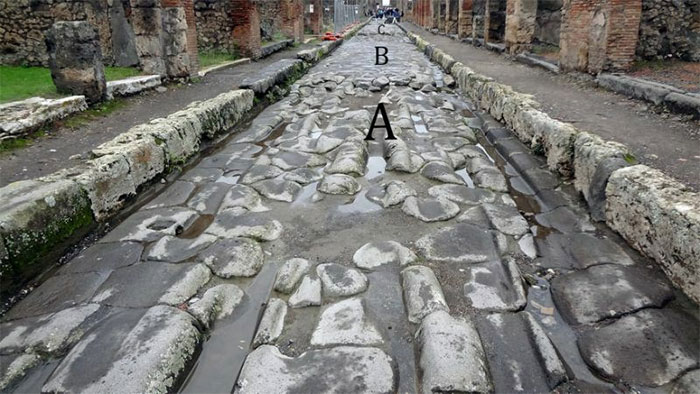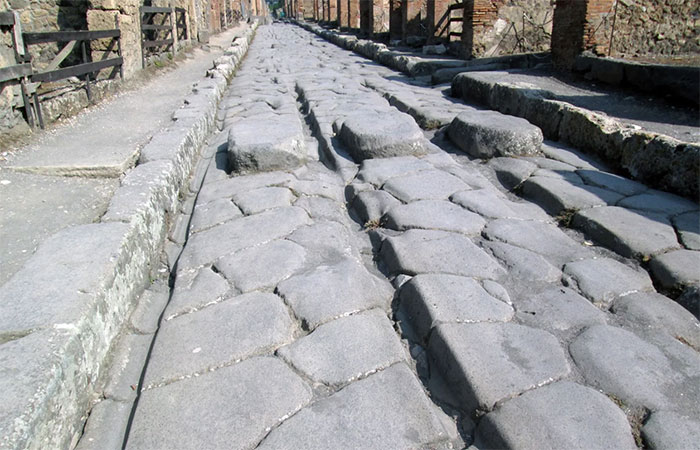Mysterious roads covered with molten iron 2,000 years ago
How the Romans made iron so hot that it could be poured gently into the broken road sections is still a mystery. After 2,000 years, some sections remain intact.
US researchers analyzed rocky roads that were surprisingly intact after nearly 2,000 years of Pompeii (ancient Roman city, now in Italy) devastated by the volcanic eruption of Vesuvius and only The city is dead. They found strange traces of molten iron on the most beautiful roads.

A photo of a road in Pompeii with sections A and C has not been repaired, section B is flat due to molten iron and some other materials - (photo provided by the research team).
In some other areas, the beautiful paved roads of Pompeii appear deep grooves. Scientists believe that it is the vestige of cars, especially large trucks with continuous horizontal loads along the roads. Before the volcano disaster killed most residents, this city was extremely bustling, traffic density was very crowded.
The number of vehicles is so many that just a few decades, stone paved roads also appear deep trenches. The Pompeii government has devised an extremely efficient and much less expensive sugar repair technology than a complete re-slice: using molten iron.

An unmodified road with deep trenches created by vehicles - (photo provided by the team).
According to the group of authors headed by Professor Eric Poehler (University of Massachusetts Amherst, USA), this is the first " large-scale endorsement " that scientists have found to prove hypotheses about the technology used. molten iron of ancient Romans. With the city life of 2,000 years, what they do is amazing.
After being melted, iron is taken by slaves to the road where it needs to be repaired and filled with broken and worn places. The durability of this repair was confirmed when nearly 2 millennia later, some of the repaired sections were found in a completely intact state. In addition to molten iron, some other materials such as stone, earthenware and ceramics are also used for road maintenance.

The convex and convex sections are also repaired by molten iron - (photo provided by the team).
However, how the Romans made iron so melted that it could be poured gently into the broken road sections is still a mystery. To get molten iron, they had to heat iron slag and scrap iron to temperatures of 1,100-1,600 degrees Celsius! Part of the answer was explained when archaeologists found some high-tech Roman kilns. They suspect that they actually achieve this temperature.
Some drops of iron falling on unrepaired roads also prove the existence of transporting molten iron. Unfortunately many road sections have not been repaired as it seems that the volcanic disaster has cut off the work.
The team said they are still learning about Pompeii as well as chemical iron analysis using this fix to find out where it is claimed. Known as an incredible modern and civilized metropolis, Pompeii surprised many archaeological groups in many countries. Sadly, the city was "buried alive" by the volcanic disaster in 79 AD, the most famous and painful symbol is the " petrified" people.
- The woman lived 61 years with iron lungs
- Mysterious iron pillar of 1,600 years old stainless steel
- Fa-rectification makes 1000km of solar-covered roads
- The iron hammer of 140 million years challenges scientists
- 'The man with the iron mask' - the mystery of mankind over the past 350 years
- What happens when you swing your hand over a molten metal?
- Decipher the mystery who runs on molten lava
- Why does the hand not burn when immersed in molten metal?
- 3 'mysterious roads' under the sea
- A severely deformed California street with no known cause
- Find an environmentally friendly metallurgical method
- Restoring the iron smelting technique that existed 2000 years ago
 Discovered an ancient centipede fossil 99 million years old
Discovered an ancient centipede fossil 99 million years old Discovered bat-like dinosaurs in China
Discovered bat-like dinosaurs in China Discovered a 200-year-old bronze cannon of the coast
Discovered a 200-year-old bronze cannon of the coast Discover 305 million-year-old spider fossils
Discover 305 million-year-old spider fossils